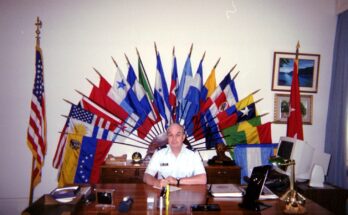In August 1939, President Franklin Roosevelt received a letter signed by Albert Einstein. The letter was not written by Einstein, rather by three of the world’s leading physicists; Leo Szilard, Edward Teller, and Eugene Wagner. The letter warned that the Germans might be working on the development of an atomic bomb and suggested that the U.S. start its own nuclear program. Thus began the Manhattan Project. The three physicists asked Einstein to sign their letter as he was the world’s most famous scientist and a Nobel Prize winner. Einstein was not part of the Manhattan Project. He was denied a security clearance based on his pacifist views. Some in our government attempted to prevent his immigration to the U.S. Among them, J. Edgar Hoover.
To head the Manhattan Project, Roosevelt selected Army General Wesley Groves. Groves was famous as the civil engineer who had constructed the world’s biggest office building, the Pentagon, in just 17 months.
The Manhattan Project was centered at three locations; Oak Ridge, Tennessee, which produced U-235 and served as overall headquarters. Hanford, Washington, which produced P-239. And, Los Alamos, New Mexico, where the research and construction of bombs took place.
General Groves selected J. Robert Oppenheimer to head the research, design, and construction of the bomb. Oppenheimer recruited the world’s most famous physicists, some recently having fled oppression in Europe. Canadian and British scientists were also part of the team.
It was recognized that two elements could be used to build an atomic bomb; Uranium 235 and Plutonium 239. Also, two different designs would work. One design was a long tube with sub-critical fissile material at each end propelled to the center to by powerful explosives to meet each other and create a critical mass. The other design was a sphere with a subcritical ball of fissile material in the center. When simultaneous high explosive charges were detonated around the surface of the sphere the compression could squeeze the ball into a smaller area reaching critical mass. The “gadget”, the first bomb ever exploded, was a spherical device using Plutonium as the U.S. had more Plutonium than Uranium. It lit up the New Mexico desert on 16 July, 1945
Many of the scientists working to create the atomic bomb had mixed emotions about its use. Some became pacifists after the war. A number of low level spies were detected during the project. Two, Julius and Ethyl Rosenberg, were executed. The top spy was never detected until years after the war. He was Klaus Fuchs, a German physicist who had fled to England as Hitler rose to power in Germany. He became an English citizen before being assigned to the Manhattan project in New Mexico. He was sending reports on bomb development to the Russians. It is estimated that his spying advanced the Russian program by three years. He never accepted any pay for his spying. His belief was that no single country should possess nuclear weapons, hence he helped the Russians to develop one. He returned to England and in 1950, was convicted of violating the Official Secrets Act. He could not be charged with treason as Russia was an ally at the time he did his spying. Today it is estimated that more than 12,000 nuclear weapons exist. Eight countries have them; the United States, Russia, France, England, China, India, Israel, and Pakistan.



